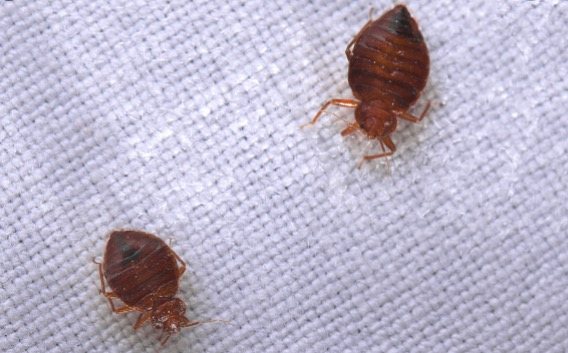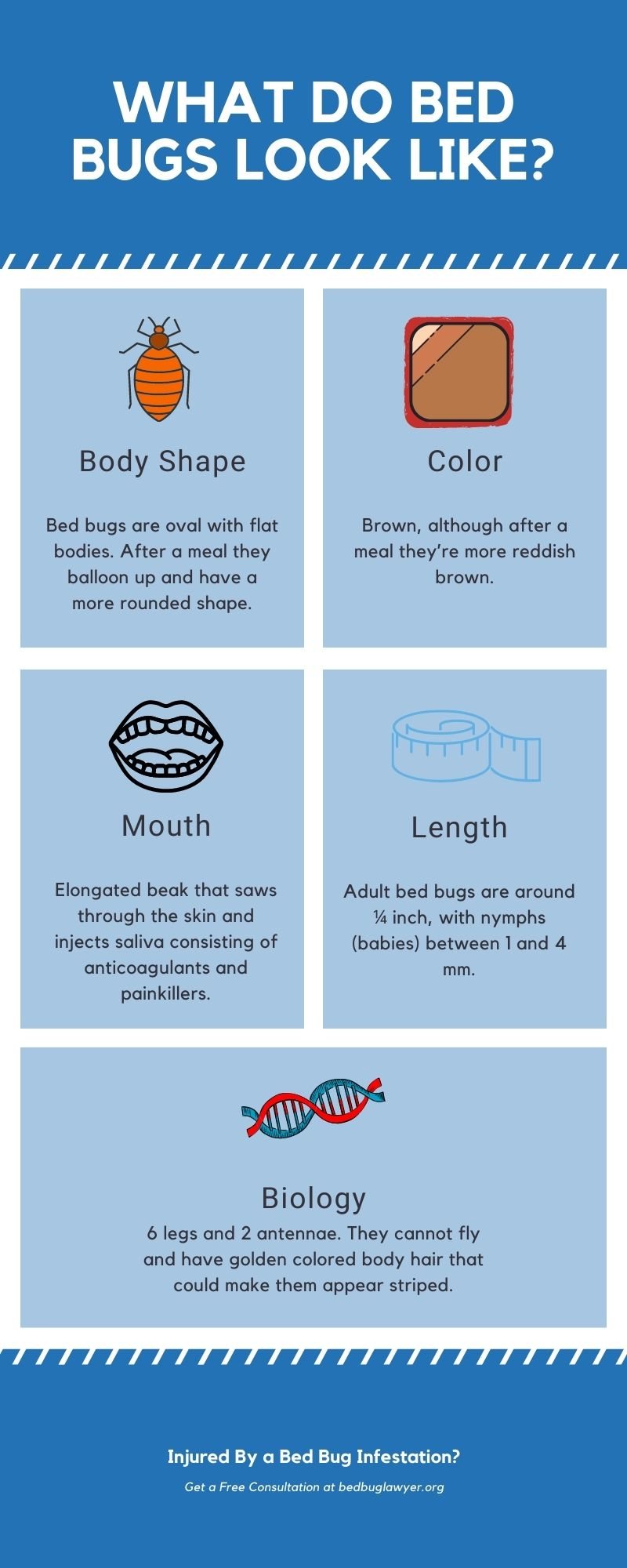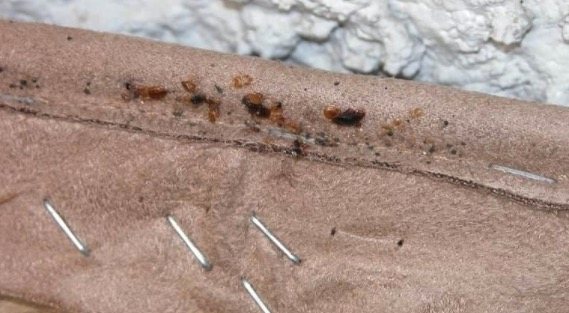Discovering that you have a bed bug infestation is nothing short of a nightmare.
Whether you saw them scurry by as you got ready for bed….
Or noticed a cluster of bites on your skin.
These insects can turn your life upside down in so many ways.
Largely eradicated in the mid 20th century, these bugs have since made a comeback.
Now infestations are worse than ever, with reported cases in all 50 states.
Once you suspect an infestation – You can only wonder….
Where do bed bugs really come from?
Let’s take a look at some of the main causes as to how your home became infested with these irritating creatures.
Page Contents:
What Exactly Causes Bed Bugs?
There are several main causes of bed bug infestations.
A few of them include:
- International travel.
- The sale of second-hand furniture.
- New accommodation.
- General lack of awareness.
All of these can contribute to an infestation and can cause these pests to spread quickly.
A common misconception is that…
Bed bugs are limited to untidy bedrooms and areas with poor sanitation.
But the fact is there are many ways bed bugs can thrive and travel from one place to another.
Bed bugs can spread by hitchhiking on luggage, handbags, clothes…
Or in very rare cases:
On your body.
1. Bed Bugs Can Travel
These bugs often spread out to different locations through national or global travel.
They are, simply put, excellent hitchhikers and frequently travel through luggage.

Hotels and other similar hospitality facilities are among the most popular due to their level of foot traffic.
With so many people coming and going, bed bugs have plenty of opportunities to infest hotels.
In fact, hotels are in the top 3 in terms of structures most infested with bed bugs.
To put that in perspective…
Hotels are responsible for 27 percent of bed bug cases nationwide. (Source: NY Bed Bug Specialist)
2. Used Furniture Sales
Similar to luggage, rental furniture or furniture sold at secondhand stores could also carry bed bugs.
Commonly infested used furniture includes:
- beds
- couches
- And chairs.
Particularly when infested with female bed bugs and/or eggs, chances are that the new owner or renter will experience an infestation.
Despite their name, bed bugs don’t simply live in the bedroom.
In fact, they’ve managed to find homes in just about any furniture imaginable.
(As long as there are dark and damp spaces to reside).
3. New Visitor Accommodations
With the popularity of services such as Airbnb, more homeowners are likely to experience bed bug infestations as a result of new accommodation.
More and more residences are being used to accommodate travelers from all over the world, giving bed bugs a chance to move quickly and find a new home for themselves.

4. Lack of Awareness
Another contributor to the infestation and spread of bed bugs is a general lack of awareness…
Especially on the part of property owners and landlords.
This is why bed bug infestations are a major contributor to landlord-tenant disputes.
Many people are unaware of how to properly identify bed bugs or how to prevent an infestation.
It’s important to learn how to treat bed bug bites, or how to properly inspect a hotel room before you go to sleep.
Where Do Bed Bugs Come From in Nature?
Bed bugs have been around for longer than you can imagine. A recent DNA analysis and study in 2019 found that bed bugs have been around for close to 115 million years.

It’s natural to think that bed bugs had to live somewhere before they infested people….
Though it’s true bed bugs did walk the earth in the time of the dinosaurs, the natural habitat of the common bed bug (Cimex Lectularius) is now the human home.
So Where Did Bed Bugs Live in Nature?
While they are often associated with human habitats like homes, hotels, and hostels, their natural habitat was believed to be caves where they originally fed on bats. When early humans began occupying these caves, bed bugs began feeding on human blood.
Over time, as humans built homes and expanded their territories, bed bugs adapted to these new environments, leading to the widespread infestations we see today.
Bed bugs were known to humans as early as 400 BC, in the days of Ancient Greece. In that time, they have spread to every corner of the inhabited world.
In the past, bed bugs had a particular affliction for the poor and would infest mass shelters. Nowadays with the modern resurgence, tourists are now impacted as well.
However, in the wild, they can still be found in nests or habitats of their original hosts, like bats.
The Biggest Myth About Bed Bugs
A major misconception of bed bugs is that they thrive in dirty environments.
In fact, under the right circumstances, Bed bugs can live in run-down apartments or 5-star hotels.

The reason the stigma of bed bugs is associated with dirty, poorer environments has more to do with the ability to identify and remove an infestation…
Rather than where bed bugs prefer to reside.
People in nicer, more luxurious environments will spot an infestation more quickly, leading to proper treatment before the infestation has a chance to spread.
Why Do Bed Bugs Exist?
Bed bugs, like all organisms, exist as a result of evolution and the ecological niche they occupy. They evolved as parasites, feeding on the blood of larger animals, initially probably bats, before transitioning to humans.
To break it down further, their existence can be attributed to several factors:
1. Adaptation:
Bed bugs are highly adapted to a parasitic lifestyle. Their flat bodies allow them to hide in tiny crevices, and they’ve developed anesthetic and anticoagulant agents in their saliva to feed without detection.
2. Reproduction:
Bed bugs reproduce rapidly, with females laying hundreds of eggs in their lifetime, ensuring their survival as a species.
3. Human Migration:
As humans traveled and migrated, they inadvertently transported bed bugs, facilitating their spread.
4. Survival Skills:
Bed bugs can go months without feeding and have developed resistance to many pesticides, making them challenging to eradicate.
5. Ecological Role:
In nature, every organism, including pests, plays a role in the ecosystem. Bed bugs serve as food for certain predators and help control the population of their host species.
Their existence, while inconvenient and distressing for humans, is a result of millions of years of evolutionary success in their niche.
How to Identify an Infestation
One of the reasons so many people are unaware of how to spot a bed bug infestation is that bed bugs are superb at hiding in hard-to-reach places.
They typically take residence in dark, damp spaces where they aren’t easily seen, only leaving these areas when seeking food, typically at night.
Many may not notice the presence of bed bugs until they wake up with irritated skin. These insects are nocturnal and small, so finding them can be difficult.
So how do you properly detect an infestation?
Ideally, you see the physical bed bug.

So, let’s talk about what these creatures look like, since they can be easily confused with similar looking insects.
What do Bed Bugs Look Like?
The infographic below summarizes key physical bed bug traits.

Other Bed Bug Traits
The bed bug’s life begins with the egg, which is a milky-white color.
It then becomes a nymph and eventually reaches adulthood. The lifespan of a single bed bug is around 4 to 6 months.
Young bed bugs go through 5 molts (shed their skin 5 times) before reaching maturity.
The female bed bug lays between 6 to 12 eggs each day (can get up to 500 eggs in her lifetime).
This is why, even if you spot one bed bug, it could easily turn into a severe infestation over time.
If you’re unable to spot physical bed bugs (we get it, it’s hard).
There are other ways of identifying an infestation….
Such as looking for the signs or evidence that an infestation is present.
Signs of Bed Bugs
There are several signals to determine if a space is infested with bed bugs…
Apart from visible bites, these include:
- Dark red or black stains on a mattress or bed frame.
- A certain musty or sweet scent.
- Dark blood spots on bedsheets.
- Bed bug eggs or the molted shells that they leave behind.

Taking steps to inspect your home can help avoid an infestation or identify an existing one for mitigation.
If you don’t see any of these signs but still suspect an infestation, there are some other less common areas where bed bugs can be found.
These include:
- Your Walls:
Contrary to popular belief, bed bugs can travel through the walls.
And this is why…
If you live in an apartment complex or multifamily building, you can easily catch bed bugs from neighbors.
2. Kitchen Appliances and Tabletop Furniture:
Though bed bugs like to hide less than 10 feet from where they feed (hence the bedroom) ….
In severe infestations bed bugs can be found almost anywhere.
This includes behind or under your appliances or decorative objects that sit on:
Tables, shelves, or benches.
3. Your Pets:
This is a rarer situation.
However, there have been reported cases where the origin of the infestation started with the family pet.
Fleas are the more likely insect to affect your outdoor pets, but bed bugs are avid hitchhikers, and will go to great lengths to infest a home.
For these reasons, it’s critical to learn more about how bed bugs can infest your pets.

How to Get Rid of Bed Bugs
Now that you have properly identified an active infestation, the next step is to prepare for treatment.
There are a variety of treatment options available at your disposal….
Let’s go through some of the most common bed bug treatments, as well as the benefits of each.
1. The DIY Treatment
This involves treating a bed bug infestation yourself using home remedies.
Benefits:
- This is the cheapest method of bed bug treatment.
- Good for localized infestations.
- Very discrete. You won’t have to worry about people outside noticing that you have an active infestation.
Examples of DIY methods of treatment include:
- Vacuuming – Vacuum your home thoroughly getting at bed bug hot spots like underneath furniture. Use attachments to get at hard-to-reach areas.
- Diatomaceous Earth – Apply this chemical around the seams of your mattress, bed frames, and furniture. It is meant to cause bed bugs to die of dehydration.
- Mattress Encasements – This is a cover for the mattress and box spring. Bed bugs caught on the inside will starve, and bed bugs caught on the outside will be easier to see and can’t get into the mattress to hide.
2. The Conventional Bed Bug Treatment
This involves hiring a pest control specialist to treat your infestation with insecticides.
Benefits:
- This is a proven option for treatment, as pest control companies have been using chemicals to treat bed bugs for decades.
- As far as professional bed bug treatments go, this is going to be moderately priced (Between $300 to $1,500 depending on the size of the infestation).
- It’s somewhat discrete. An insecticide treatment may only require one specialist to get the job done. This is good if you’re nervous about neighbors finding out you have an infestation.

The Bed Bug Heat Treatment
Bed bugs cannot survive temperatures above 120 degrees Fahrenheit for more than a few hours.
This treatment method involves hiring a company to bring industrial heating equipment to raise the temperature of your home for an extended period of time.
Benefits:
- Good for Severe Infestations. If done properly, this treatment penetrates every inch of your home with heat.
- Though this option is more expensive (Can cost up to $5,000) it typically eradicates an infestation within only one treatment.
- This treatment method doesn’t use harsh chemicals that could be damaging to the environment.
If you’re interested in learning more about this treatment…
Luckily we wrote the definitive guide on all you need to know about professional bed bug heat treatments.

Interesting Bed Bug Facts
Preventing, identifying, and removing bed bugs are the 3 phases to ridding yourselves of an infestation and preventing recurrence.
To accomplish these things, you’ll need to understand bed bugs inside and out…
That being said let’s look at a few interesting bed bug facts and statistics.
1. Bed bugs can ingest 7 times their own body weight
This is equal to the average adult holding close to 120+ gallons of liquid in their stomach all at once.
2. Bed bugs can live in just about ANY environment
These insects are hardy and incredible at survival. They can withstand a wide range of temperatures, and if the conditions are right, they can live up to a year without food.

On a global scale, bed bugs inhabit 6 of the 7 continents.
Antarctica is the sole exception, given the below-freezing temperatures and lack of a human population.
3. A woman let 20,000 bed bugs bite her
A researcher named Regina Gries has let these pests bite her for many years. She uses herself as a test subject in her project to develop pheromone traps that catch bed bugs.
4. Bed bugs were once used for medical treatments.
In the days of the Roman Empire, bed bugs were believed to treat basic injuries and illnesses, such as snake bites or ear infections. Naturalists of the time supported this idea, and bed bugs continued to be used medicinally long after the Empire fell into ruin.
It wasn’t until the 1700s, over a millennium and countless advances in medicine later, that public perception of bed bugs changed from a “viable” medical treatment to a nuisance that needed to be removed.





Interesting. I like that infographic… It was a bit confusing at first but then I seemed to get it. I’m trying to freeze bed bugs myself because I don’t want to pay for heat treatment. We will see what happns!
Well written article. The only thing that doesn’t make sense to me is the statement that bed bugs existed 115 million years ago and and then using BC as a time reference. You have to throw Jesus out entirely if you want to use the “millions” statements.